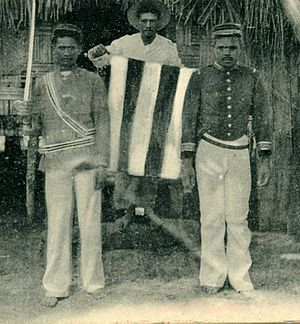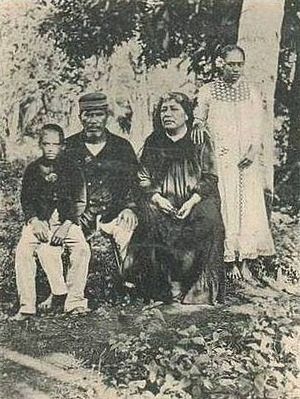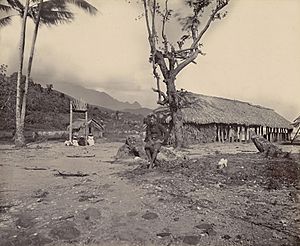Teraupo'o facts for kids
Quick facts for kids
Teraupo'o
|
|
|---|---|

Teraupo'o and his family on Raiatea, c. 1895
|
|
| Born |
Hapaitahaa a Etau
c. 1855 Avera, Raiatea
|
| Died | 23 December 1918 Vaiaau, Raiatea
|
| Known for | Resisted French rule from 1887 to 1897 during the decade-long Leeward Islands War |
Teraupo'o (born around 1855 – died 23 December 1918) was a brave Tahitian leader. He came from the islands of Raiatea and Tahaa. Teraupo'o led a fight against French control from 1887 to 1897. This long fight was known as the Leeward Islands War.
Teraupo'o was born in the village of Avera, on the island of Raiatea. He was a local chief. He became unhappy with the French after a bad experience with a French officer. When the king of Raiatea, Tamatoa VI, agreed to French rule, Teraupo'o refused to give up.
He gathered people to resist the French. He even set up a new government with Tuarii as queen. Teraupo'o and his followers were called the Teraupiste. They fought for ten years, hoping the British would help them stay independent. The French sent more soldiers to stop the resistance. Teraupo'o was captured in 1897. He was sent away to New Caledonia but later returned to Raiatea. He lived a quiet life until he died in 1918.
Teraupo'o's Early Life
Teraupo'o was born around 1855. His birth name was Hapaitahaa a Etau. He was from Avera, a village on the east coast of Raiatea. This island is part of the Leeward Islands in the Society Islands.
He was also known as Taraiupo'o, which means "Headhunter." Later, he used the name Teraupo'o, meaning "This Head" in the Tahitian language. He was a chief of a smaller family group.
In the early 1800s, British missionaries came to the Society Islands. They taught the people about Protestant Christianity. The local leaders, called ari'i rahi, supported these missionaries. Over time, a British style of government changed how power was shared. Local chiefs gained more power.
Before Teraupo'o was born, the nearby Kingdom of Tahiti came under French control. But France and Great Britain agreed in 1847 that the Leeward Islands, including Raiatea, would stay independent.
A French historian named Auguste Charles Eugène Caillot wrote about Teraupo'o. He said Teraupo'o became angry with the French after a French captain treated him badly.
French Control in Raiatea
In 1880, King Tahitoe of Raiatea agreed to let France protect his island. But his people did not like this. They removed him from power. His daughter, Queen Tehauroa, tried to get help from the British to keep Raiatea independent.
However, on 16 March 1888, France officially took control of Raiatea and Tahaa. This happened after France and Great Britain changed their earlier agreement from 1847.
The last independent king of Raiatea, Tamatoa VI, was from another island. In 1887, some chiefs asked the French to send an administrator. But Teraupo'o refused to obey King Tamatoa VI's order to surrender to the French. He started building a resistance group in 1887.
French warships came to Raiatea. They changed local court decisions to help some unhappy European settlers. This made many people against the French even angrier. A missionary named William Edward Richards wrote that King Tamatoa "gave up his power" rather than help the French. The French also attacked some villages and burned houses. This made the people of Raiatea even more determined not to give up. King Tamatoa VI then left Raiatea, and the island was left without a king.
The War of Resistance
In 1888, the missionary Richards noted that almost everyone in Raiatea joined together to fight the French. Teraupo'o became the leader of this resistance. He set up a new government in Avera with Tuarii, a daughter of the former King Tahitoe, as queen.
The French set up their base in the old capital of Uturoa. They appointed a French official and had the support of a chief from Tahaa named Tavana. A long war began. The French could not enter the countryside because the local people used guerilla warfare. This conflict became known as the Leewards War or the Teraupo'o War.
Teraupo'o carried his rifle, which he called the "red pepper." He was able to gather about 800 men to fight. His followers were known as the Teraupiste. Teraupo'o's brother, Hupe, was his main general. Other brave leaders, like Chiefess Mai and Chief Faterehau, also joined him. Some foreign residents also helped Teraupo'o. A German man named G. Neuffer became like a son to Teraupo'o and gave him weapons and money.
Teraupo'o believed that Great Britain would help them. The people of Raiatea asked the British Consul in Tahiti for help. They even offered their country to the "Great White Queen" (Queen Victoria). In 1895, Queen Tuarii traveled to Rarotonga to ask for British help, but she was not able to meet with the British official there.
People tried to make peace, but it did not work. A French missionary, Pastor Gaston Brunel, often visited Teraupo'o's camp. He understood the reasons for the rebellion. The famous artist Paul Gauguin saw the end of the rebellion. He noted that talking did not convince the people of Raiatea to surrender.
The French sent Governor Gustave Gallet to stop the rebellion. Governor Gallet had experience putting down other rebellions. In 1896, two French warships arrived from New Caledonia. They brought 200 French soldiers and a group of Tahitian volunteers.
On 27 December 1896, Governor Gallet tried to talk to the rebels to avoid fighting. He gave them a deadline to surrender by 1 January 1897. Queen Tuarii and 1700 rebels in Avera sadly surrendered. But Teraupo'o and the rebels from Tahaa refused. This led the French to attack. The French soldiers defeated the native forces, who were not well-equipped. Many rebels ran into the mountains to hide.
The armed resistance ended when Teraupo'o was captured. He, his wife, and daughter hid in a cave in the Faneuhi mountain. They blocked the cave entrance with a large rock during the day. But on the night of 15–16 February 1897, light from their fire showed their hiding place. Teraupo'o was led out of the cave at gunpoint. His family stayed defiant. The fighting had lasted about six weeks, and nearly fifty people died, mostly Raiateans.
Exile and Death
After Teraupo'o was captured, the French government in Paris announced the end of the war. France officially took control of the islands on 19 November 1897.
The captured resistance leaders, including Teraupo'o, were sent away to Nouméa, New Caledonia. Some of their followers were sent to the Ua Huka in the Marquesas Islands. Others were forced to work on building roads in Raiatea. Teraupo'o, his wife, and his brother Hupe stayed in New Caledonia until 1905.
Teraupo'o was allowed to return to Raiatea in 1905. He lived a quiet life and did not speak much about the past. He died in Vaiaau on 23 December 1918. This was during the time of the Spanish flu epidemic. His grave is now located at Pamatai point.




